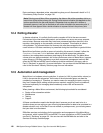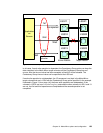Chapter 13. Metro Mirror options and configuration 137
In other words, the order of updates was not the same as it was for the source data, but the
order of
dependent writes was preserved.
13.3.2 Consistency Group function - how it works
In the operation of the Consistency Group function of Metro Mirror we distinguish two parts.
One is the invocation of the Consistency Group option, and the other one is the freeze/run
operation. Together, they make it possible for the disk subsystem to
hold I/O activity and
subsequently to
thaw the held I/O activities.
Consistency Group option
The Consistency Group option causes the disk subsystem to hold I/O activity to a volume for
a time period by putting the source volume into a
extended long busy state when the DS6000
detects a condition where it cannot update the Metro Mirror target volume. This operation can
be done across multiple LUNs or volumes, multiple LSSs, and even across multiple disk
subsystems. You can specify this option when you are defining Metro Mirror paths between
pairs of LSSs, or when you change the default Consistency Group setting on each LSS (the
Consistency Group option is disabled by default).
In the disk subsystem itself, each command is managed with each logical subsystem (LSS).
This means that there are slight time lags until each volume in the various LSSs is changed to
the
extended long busy state. Some people are concerned that the time lag causes you to
lose data consistency, but that is not true. We explain how to keep data consistency in the
Consistency Group environments in the following section.
In the example in Figure 13-2, three write operations (first, second, and third) are
dependent
writes. This means that these operations must be completed sequentially.


















